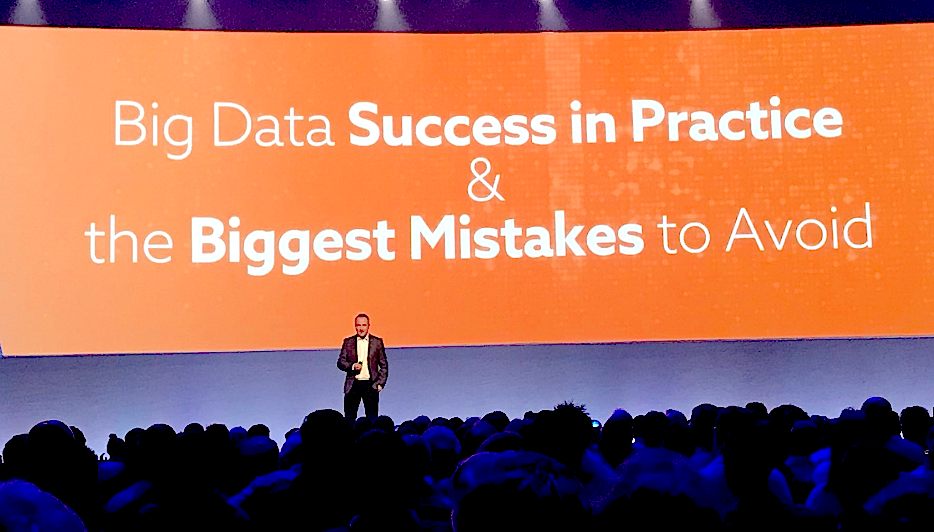 BIG DATA
BIG DATA
 BIG DATA
BIG DATA
 BIG DATA
BIG DATA
Big-data repositories hold much of the world’s personally identifiable data. Many data management professionals are now laser-focused on the European Union’s General Data Protection Regulation or GDPR, which will take effect in little over a month and will place strict data-stewardship mandates on any enterprise that does business in any of those nations.
Since it was founded in 2011, Hortonworks Inc. has evolved from a Hadoop big-data software distribution startup to a diversified provider big-data governance tooling for private, public, hybrid and multicloud deployments. GDPR is now the principal global focus in that regard, though other country- and sector-specific laws, such as HIPAA in the U.S., are still a driver of demand for such capabilities. As I discussed in this recent article, GDPR mandates stringent enterprise controls on processing, movement and use of the personal data of the citizen of EU member states, and imposes significant financial penalties for failure to maintain them.
At this week’s DataWorks Summit in Berlin (* disclosure below), GDPR was the predominant focus, but it was far from the only topic. As John Kreisa, Hortonworks’ marketing vice president, said on theCUBE at the event, the vendor’s growing customer base is increasingly investing in its predominantly open-source-based products, as well as those of its more than 2,300 partners, to drive the “internet of things,” stream computing, data science, artificial intelligence, machine learning, data warehousing, cybersecurity and other important applications. In addressing these opportunities, Hortonworks continues to take a community-led market strategy focusing on open-source technology, as company founder Alan Gates discussed in this Cube interview.
There were well-attended breakout tracks on these and other emerging technologies at DataWorks Summit. On theCube, we had great discussions with a Hortonworks financial-service customer in Germany who’s building an enterprise data lake, as well as partners in Uruguay and South Africa working customer projects with a data science focus. For a good discussion of how the Hortonworks and its partners are generally addressing opportunities in data science, AI and related areas, check out this Cube interview with Piotr Mierzejewski, program director for IBM’s Data Science Experience solution, for which Hortonworks is a principal reseller.
Nevertheless, there’s no denying that GDPR’s looming deadline, which is barely a month away, has caused Hortonworks customers to bump compliance-related data-stewardship projects to the top of their priority stacks. As influential big data analytics expert Bernard Marr (pictured at DataWorks) told me on theCube:
That explains why the event’s main news was Hortonworks’ announcement of the new Data Steward Studio, a software-as-a-service offering that helps enterprises to automate their GDPR-compliance processes. Launched from the conference mainstage in the Day One keynote by Chief Technology Officer Scott Gnau, the new offering is now in technical preview and is slated for general availability later in this quarter. It is going to market as a component of the larger Hortonworks DataPlane Service family of services for managing complex big-data multi-clouds.
As Gnau told me on theCUBE later that day:
As demonstrated by Srikanth Venkat in the Day Two keynote, Data Steward Studio supports the following privacy-protecting data-stewardship practices:
Metadata is the heart of the big-data catalog that powers Data Steward Studio. The solution enables enterprise data administrators to search, catalog, classify, tag and manage data globally based on origin, value, protection level, sensitivity or functional use, as well as other descriptive metadata. It enables data stewards to analyze data lineage and impact. It can also secure both the personal data and associated metadata in keeping with enterprise-wide authorization, data protection and anonymization policies.
For a great discussion of metadata’s central role in big-data catalogs such as the one underpinning the new Hortonworks offering, check out my Cube interview of IBM Distinguished Engineer Mandy Chessell. The gist of her discussion was the following:
To view these and other Cube interviews from DataWorks Summit 2018 Berlin, please visit this page. Here are all my interviews and keynote analyses for both Day One and Day Two. (* Disclosure: TheCUBE was a paid media partner for DataWorks Summit 2018. Neither Hortonworks, the event sponsor, nor other sponsors have editorial control over content on theCUBE or SiliconANGLE.)
Support our open free content by sharing and engaging with our content and community.
Where Technology Leaders Connect, Share Intelligence & Create Opportunities
SiliconANGLE Media is a recognized leader in digital media innovation serving innovative audiences and brands, bringing together cutting-edge technology, influential content, strategic insights and real-time audience engagement. As the parent company of SiliconANGLE, theCUBE Network, theCUBE Research, CUBE365, theCUBE AI and theCUBE SuperStudios — such as those established in Silicon Valley and the New York Stock Exchange (NYSE) — SiliconANGLE Media operates at the intersection of media, technology, and AI. .
Founded by tech visionaries John Furrier and Dave Vellante, SiliconANGLE Media has built a powerful ecosystem of industry-leading digital media brands, with a reach of 15+ million elite tech professionals. The company’s new, proprietary theCUBE AI Video cloud is breaking ground in audience interaction, leveraging theCUBEai.com neural network to help technology companies make data-driven decisions and stay at the forefront of industry conversations.